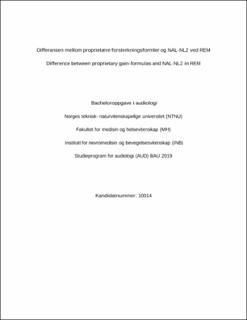| dc.contributor.advisor | Rosvoldaunet, Lars Gunnar | |
| dc.contributor.author | Brekka, Rune | |
| dc.contributor.author | Mo, Birger | |
| dc.contributor.author | Sverdrup, Tale Nilssen | |
| dc.date.accessioned | 2022-07-21T17:19:28Z | |
| dc.date.available | 2022-07-21T17:19:28Z | |
| dc.date.issued | 2022 | |
| dc.identifier | no.ntnu:inspera:107342744:17262329 | |
| dc.identifier.uri | https://hdl.handle.net/11250/3007584 | |
| dc.description.abstract | Sammendrag
Bakgrunn: Avhandlingen baserer seg på antagelsen av at “first-fit” tilpasninger ikke gir tilstrekkelig forsterkning, noe som har blitt utforsket ved tidligere studier.
Formål: Formålet med denne avhandlingen er å utforske ulikhetene mellom proprietære forsterkningsformler og NAL-NL2 for å kunne vise relevansen til REM ved en høreapparattilpasning. Metode: CARL, en testdukke med standardiserte øreganger ble benyttet til å teste fire RITE apparater tilpasset med proprietær “first-fit”, NAL-NL2 “first-fit” og verifisert NAL-NL2. Et fallende og et flatt hørselstap ble benyttet til programmering av høreapparatene for å se hvordan formen på hørselstapet påvirket forsterkningen.
Resultat: Resultatene viser betraktelig underforsterkning i diskanten ved “first-fit”, og i bassen ved flatt hørselstap. Det var forskjeller mellom de ulike produsentenes “first-fit” NAL-NL2 i forhold til deres proprietære forsterkningsformler. SII-verdiene var også lavere ved “first-fit”. Konklusjon: “First-fit” ved bruk av både de proprietære forsterkningsformlene og NAL-NL2 viser tendenser til underforsterkning i diskant. Dette påvirker evnen til å oppfatte deler av talesignalet negativt, og kan føre til redusert taleoppfattelse. Ved bruk av SII som indikator for mulig taleoppfattelse ble det funnet at høreapparater verifisert med REM kan gi bedre tilgang på taleinformasjon. Det ble også funnet variasjon mellom produsentenes NAL-NL2 “first-fit”. Dette kan tyde på at de ulike produsentene bruker egne modifiserte versjoner av forsterkningsformelen. Ved å benytte REM ved høreapparattilpasning kan underforsterkning reduseres. Det anbefales derfor å bruke REM i klinisk sammenheng. | |
| dc.description.abstract | Summary
Background: This study is based on the assumption that first-fit in hearing aids does not give adequate gain, which has been explored in earlier studies.
Purpose: The purpose of this study is to investigate the differences between proprietary gain-formulas and NAL-NL2 as to present the relevancy of REM in hearing aid fittings.
Methods: CARL, a patient simulator with standardized ear-canals was used to test four RITE hearing aids with proprietary first-fit, NAL-NL2 first-fit and verified fitted NAL-NL2. A sloping audiogram and a flat audiogram were used as the basis for programming the hearing aids to see if this affected the gain for the hearing aids.
Results: The results show significant difference between the gain in the hearing aids and target curve in REM. The hearing aids do not give enough gain in either high or low frequency according to REM. There is also a significant difference in NAL-NL2 between all the hearing aids. First-fit hearing aids scored lower on SII than verified hearing aids.
Conclusions: In first-fit of the hearing aids, both the proprietary and NAL-NL2 fitting did not give enough gain at higher frequencies, which affects segments of the speech-signal negatively. This could lead to reduced speech perception. By using SII as an indicator for possible speech perception, it was found that hearing aids verified using REM may give greater access to speech information. Variations between the different manufacturers' NAL-NL2 first-fit was also found. This may indicate that the individual manufacturers are using their own modified versions of the fitting formula. By using REM in hearing aid fitting, under-amplification can be reduced. It is therefore recommended to use REM in clinical work with patients. | |
| dc.language | nob | |
| dc.publisher | NTNU | |
| dc.title | Differansen mellom proprietære forsterkningsformler og NAL-NL2 ved REM | |
| dc.type | Bachelor thesis | |
